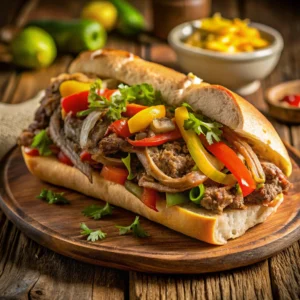Chili dogs and Coney dogs are two beloved staples of American cuisine, each offering a unique take on the classic hot dog. Whether you’re savoring a rich, bean-laden chili dog or biting into the tangy simplicity of a Coney topped with mustard and onions, these hot dog variations showcase the creativity and flavor that define regional comfort food. Both have become symbols of culinary ingenuity and are celebrated at ballparks, diners, and food festivals nationwide.
For those who love hearty meals, chili dogs feature a thick, savory chili topping often paired with cheese and jalapeños. In contrast, Coney dogs are known for their lighter, beanless sauce, served with a hint of tang from mustard and onions. Despite their differences, both have a rich history rooted in immigrant influences and American traditions. To explore other bold and satisfying dishes, consider this Chili Dog Casserole Recipe, a baked version of the classic chili dog that’s perfect for gatherings.
This article will take you on a journey through the origins, ingredients, and regional variations of chili and Coney dogs. You’ll also discover how to serve and pair them with complementary sides like this Sourdough Bagel Recipe or creative options such as Mini Pancakes Creative Recipes. With helpful tips and insights, you’ll gain a deeper appreciation for these iconic American dishes and perhaps even inspire your next family cookout.
Origins and History
The Chili Dog: A Hearty Creation
The chili dog traces its roots back to the early 20th century in America, when diners and street vendors sought to create a more filling version of the traditional hot dog. By adding a topping of hearty beef chili, they transformed the classic snack into a satisfying meal. Initially popularized in Texas, a state synonymous with bold, spicy flavors, chili dogs quickly spread nationwide.
Chili dogs gained prominence due to their adaptability. Variations emerged based on regional tastes, with some featuring sweet, bean-filled chili and others highlighting fiery, beanless recipes. Their association with comfort food culture and sports stadiums further cemented their status as an American favorite.
The Coney Dog: Immigrant Innovation
The Coney dog has a rich cultural history tied to Greek and Macedonian immigrants who arrived in the U.S. during the early 1900s. Seeking to establish a foothold in the culinary industry, they created a unique hot dog variation inspired by their traditional recipes. The name “Coney” likely nods to Coney Island, New York, a place synonymous with the rise of hot dog stands.
Unlike chili dogs, Coney dogs feature a lighter, beanless meat sauce seasoned with a blend of warm spices. Cities like Detroit, Flint, and Cincinnati embraced the Coney dog, each developing its own style. Today, the Coney dog is a symbol of regional pride and a must-try dish for anyone exploring American culinary traditions.

Key Differences Between Chili Dogs and Coneys
Although chili dogs and Coney dogs might seem similar at first glance, several key factors set them apart, from their ingredients to their flavor profiles and preparation techniques. Understanding these differences can help you fully appreciate these classic hot dog variations.
Ingredients
Chili Dogs:
- Chili: Topped with a hearty, beef-based chili that often contains beans and a rich tomato base.
- Toppings: Frequently garnished with shredded cheese, diced onions, sour cream, and jalapeños for extra flavor and texture.
- Bun: Typically served in a soft, sturdy bun to hold the thick chili and toppings.
Coney Dogs:
- Coney Sauce: A distinct, beanless meat sauce with a thinner consistency, flavored with warm spices like paprika, cumin, and sometimes cinnamon.
- Toppings: Traditionally topped with yellow mustard and finely diced onions.
- Bun: Served in steamed buns, enhancing the sauce’s smooth texture.
Flavor Profiles
Chili Dogs:
- Rich and Hearty: The combination of robust chili and savory hot dogs creates a bold and filling flavor.
- Customizable Spice Levels: Depending on the chili recipe, it can range from mildly spiced to extra hot.
- Layered Tastes: The addition of beans, tomatoes, and cheese adds a variety of flavors in every bite.
Coney Dogs:
- Tangy and Simple: The mustard and onions provide a tangy contrast to the savory, spiced meat sauce.
- Less Complex: With fewer toppings and a lighter sauce, the hot dog itself is more prominent in flavor.
- Smoother Texture: The absence of beans in the Coney sauce results in a silkier, more uniform topping.
Preparation Techniques
Chili Dogs:
- Chili Preparation: Often slow-cooked for hours to develop a deep, rich flavor.
- Hot Dog Cooking: Hot dogs are typically grilled or boiled before being placed in a bun.
- Topping Assembly: Chili and other toppings like cheese and onions are added generously, creating a messy yet satisfying dish.
Coney Dogs:
- Coney Sauce Preparation: The sauce is simmered with ground meat and spices, resulting in a lighter and tangier consistency.
- Hot Dog Cooking: Similar to chili dogs, hot dogs are boiled or grilled.
- Final Touches: Mustard, onions, and sauce are layered carefully, allowing the toppings to complement without overpowering.
Serving Styles
- Chili Dogs: Known for their bold, loaded presentation with generous toppings piled high. Often served with sides like fries or onion rings to balance the hearty flavors.
- Coney Dogs: Simpler and neater in appearance, focusing on the interplay between the sauce, mustard, and onions. They are often enjoyed with lighter sides like potato chips or coleslaw.
Regional Influences
- Chili dogs vary greatly depending on the region, incorporating local flavors such as Tex-Mex or Southern-style chili.
- Coney dogs have distinct regional styles, including Detroit Coney, Flint Coney, and Cincinnati Coney, each offering a unique take on the classic.
These differences make chili dogs and Coney dogs unique in their own right. Whether you prefer the hearty, robust flavors of a chili dog or the tangy simplicity of a Coney, both offer a delicious way to enjoy the classic hot dog.
Regional Variations
Chili Dogs Across the U.S.
- Southern-Style Chili Dogs: Southern chili dogs often feature spicy, smoky chili loaded with peppers like jalapeños or chipotles. The topping may also include BBQ sauce for an added layer of sweetness and smokiness.
- Tex-Mex Chili Dogs: Reflecting Texas’ love for bold flavors, Tex-Mex chili dogs are topped with queso, guacamole, and spicy salsa. This variation often replaces the standard bun with a tortilla for a fusion-style twist.
- Midwest Classic Chili Dogs: The Midwest embraces a heartier version, with chili featuring ground beef, kidney beans, and a touch of sweetness. Toppings like shredded cheddar cheese and diced onions are staples.
Coney Dog Styles
- Detroit Coney Dog: The Detroit Coney is characterized by its thick, beanless sauce, often seasoned with paprika and cumin. Topped with mustard and onions, it’s a beloved staple at diners across Michigan.
- Flint Coney Dog: Flint’s version stands out with its crumbly, dry-textured meat sauce made from finely ground beef and spices. It’s less saucy than Detroit’s but equally flavorful.
- Cincinnati Coney Dog: This variation is unique for its slightly sweet sauce, flavored with cinnamon and allspice. Often paired with spaghetti, it reflects Cincinnati’s culinary blend of hot dogs and chili traditions.
Toppings and Customizations
Classic Chili Dog Toppings
- Cheese: Shredded cheddar or Monterey Jack for a creamy, melty texture.
- Diced Onions: Adds crunch and a hint of sharpness.
- Sour Cream: Provides a tangy contrast to the savory chili.
- Jalapeños: For those who love a spicy kick.
Creative Chili Dog Twists
- Avocado Slices: Adds creaminess and a fresh twist.
- BBQ Sauce: Enhances smokiness, pairing well with chili.
- Crushed Tortilla Chips: Adds a satisfying crunch.
- Queso Dip: A Tex-Mex favorite that replaces traditional shredded cheese.
Traditional Coney Dog Toppings
- Mustard: Adds tanginess and balances the rich meat sauce.
- Diced Onions: A crunchy, aromatic topping.
Regional Variations for Coneys
- Coleslaw: A fresh and creamy addition popular in Southern states.
- Melted Cheese: Adds richness for an indulgent twist.
- Hot Sauce: For a spicier kick, common in Tex-Mex regions.
For a fun side to serve alongside your chili or Coney dog, check out these Mini Pancakes Creative Recipes to add variety to your meal.
Nutritional Comparison
Chili Dogs
- Calories: Chili dogs tend to be higher in calories due to the inclusion of beans, cheese, and rich toppings. A standard chili dog ranges from 350 to 500 calories depending on the portion size and toppings.
- Protein: Offers a significant protein boost from the hot dog and chili, making it a filling option.
- Fat Content: Often higher due to the fatty cuts of beef used in chili and cheese toppings.
Coney Dogs
- Calories: Generally lighter, ranging from 300 to 400 calories. The beanless sauce and minimal toppings make them a lower-calorie alternative to chili dogs.
- Protein: Contains lean protein from the hot dog and meat sauce.
- Fat Content: Lower than chili dogs but still rich due to the meat-based sauce.
Healthier Alternatives
- Use turkey or veggie dogs to cut calories and fat.
- Replace cheese with nutritional yeast for a dairy-free alternative.
- Opt for whole-grain buns for added fiber.
For healthier alternatives, use turkey or veggie dogs and replace cheese with nutritional yeast. If you’re looking to use leftovers creatively, try these Leftover Rotisserie Chicken Recipes for inspiration.

Serving Suggestions and Side Dishes
Pairings for Chili Dogs
- Fries: Classic French fries or curly fries are a perfect match for chili dogs.
- Onion Rings: Crispy onion rings add a satisfying crunch.
- Coleslaw: Creamy coleslaw balances the richness of the chili.
Pairings for Coney Dogs
- Potato Chips: A simple, salty side to complement the tangy Coney sauce.
- Baked Beans: Adds sweetness and pairs well with the meat sauce.
- Green Salad: A lighter option to offset the richness of the hot dog.
Beverage Pairings
- Chili Dogs: Pair with a frosty mug of craft beer for a bold flavor match or enjoy with a classic chocolate milkshake for a nostalgic touch.
- Coney Dogs: Lemonade or a crisp soda pairs well, cutting through the tangy mustard and meat sauce.
Creative Presentation Ideas
- Serve chili dogs with a side of this Sourdough Bagel Recipe for a rustic touch.
- Add a fun twist to your meal with these Mini Pancakes Creative Recipes for a surprising yet delightful pairing.
For a freshly baked side, pair your dish with this Sourdough Bagel Recipe for a rustic and satisfying meal.
FAQs About Chili Dogs and Coneys
1. What’s the Origin of the Name “Coney Dog”?
The name refers to Coney Island, New York, though the dish gained fame in Detroit and Flint, where unique sauces were created.
2. Are Coneys Always Beanless?
Yes, traditional Coney sauce is a beanless chili, but modern variations may include beans.
3. Can I Make Vegetarian Versions of These Hot Dogs?
Absolutely! Use plant-based sausages and lentil or tofu-based chili for a vegetarian option.
4. What’s the Best Type of Bun for These Hot Dogs?
Soft, sturdy buns are ideal to hold the toppings and prevent sogginess.
5. Do All Coneys Taste the Same?
No, regional differences in sauce recipes and toppings result in varying flavors.
Conclusion
Both chili dogs and Coney dogs have earned their place as American classics, beloved for their bold flavors and cultural significance. Chili dogs, with their thick, hearty chili and customizable toppings, are perfect for those who enjoy a rich, satisfying bite. On the other hand, Coney dogs, with their tangy, beanless sauce and simplicity, offer a lighter yet equally delicious option. These hot dogs are more than just food—they’re a testament to the creativity and diversity of regional cuisines.
To elevate your next meal, pair these hot dogs with fresh sides like this Sourdough Bagel Recipe or try adding a fun twist with Mini Pancakes Creative Recipes. For a heartier alternative, the Slow Cooker Taco Soup Recipe offers a comforting, flavorful experience akin to chili dogs. And if you’re looking to repurpose leftovers creatively, check out Leftover Rotisserie Chicken Recipes for inspiration.
Ultimately, the choice between a chili dog and a Coney dog comes down to personal preference. Both are iconic in their own right, offering a delicious snapshot of American culinary tradition. Whether you prefer the robust flavors of chili or the tangy simplicity of a Coney, these hot dogs are sure to bring joy to your table. Try both, experiment with toppings, and create your own perfect version of these timeless classics!
Stay Connected for More Delicious Recipes!
Love what you see? Follow us on social media for daily inspiration, exclusive recipes, and behind-the-scenes fun! Join our community on Facebook, Instagram, Pinterest, and X to stay updated on all things delicious. Don’t miss out—let’s cook up something amazing together!











You might also like these recipes
Do You Wash Chicken Keema? The Ultimate Guide to Safe Handling
The Best Side Dishes to Serve With Chili Dogs
Is It Better to Pan Fry or Oven Bake Chicken?